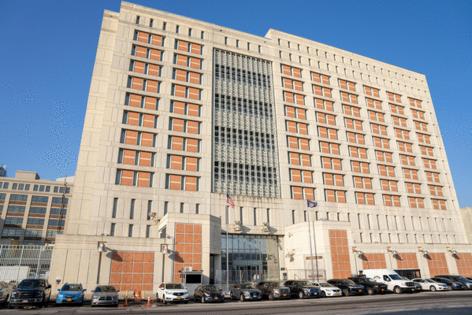Notorious New York City jail, 2 other federal facilities, to receive ICE detainees
Published in News & Features
Three new federal correctional facilities were approved to house immigrant detainees this month — including a jail in New York City known for violent and poor conditions that has held high profile individuals such as Ghislaine Maxwell and Sean “Diddy” Combs.
As the Trump administration’s mass deportation campaign strains immigration centers nationwide, the Federal Bureau of Prisons has been housing hundreds of U.S. Immigration and Customs Enforcement detainees in jails and prisons following an interagency agreement in February.
Now the Metropolitan Detention Center in Brooklyn, the Federal Correctional Institution in Lewisburg, Pennsylvania, and the Federal Detention Center in Honolulu are joining the list, according to internal communication obtained by the Miami Herald. The expansion brings the total number of approved facilities under the agreement to eight.
Benjamin O’Cone, a spokesperson for the Bureau of Prisons, confirmed the facilities in an email to the Herald, but did not share the new agreement, or answer questions about how many people each will hold and when. FDC Honolulu has held immigrant detainees under a previous agreement with ICE, but the agency declined to answer what will change.
“The Bureau of Prisons (BOP) can confirm we are assisting the United States Immigration and Customs Enforcement (ICE) by housing detainees and will continue to support our law enforcement partners to fulfill the administration’s policy objectives,” O’Cone wrote.
The agreement comes amid an ongoing understaffing crisis at the Bureau of Prisons: Thousands of positions are vacant nationwide and the agency frequently relies on overtime, according to recent Congressional testimony.
On June 16, the bureau announced the agreement expansion to staff, and noted that it has “supported the temporary detention” of over 4,000 individuals so far. The message said that because detention standards are different in the two agencies, internal audits were being conducted of the approved facilities.
The Herald reached out to ICE for comment, but did not receive a response by the time of publication.
Some federal prison employees told the Herald that the correctional facilities have space and are accustomed to similar arrangements with BOP detainees awaiting trial – but others questioned if the lockdown facilities were an appropriate place for individuals undergoing civil proceedings to determine if they can stay in the United States.
Government data of the average daily populations at ICE facilities lists the majority of immigrant detainees in BOP institutions as having “no ICE threat level” – meaning they have no criminal convictions. In all ICE facilities nationwide, about a third of detainees have no criminal history.
In May, activists and lawyers in Kansas and Florida published letters raising alarms about ICE detainees in BOP facilities. At FCI Leavenworth, civil rights organizations reported a host of issues, including frequent lockdowns for over 72 hours due to understaffing, crowded and unsanitary conditions, delayed medical care and immigrants who had won their legal cases left languishing in detention for months. At FDC Miami, attorneys wrote that their clients had been denied access to legal mail, legal documents and legal counsel.
A recent Miami Herald investigation also found long lockdowns, harsh conditions and the use of force at the federal detention center in downtown Miami, including an April incident in which officers threw crowd control grenades into a room of protesting ICE detainees.
Andrew Dalack, a trial attorney in New York who has represented clients at MDC Brooklyn for over seven years, described the facility as a “tinderbox environment.” In July 2024, one of his clients was stabbed and killed by another inmate, said Dalack, who works for Federal Defenders of New York, a non-profit organization.
The decision to house ICE detainees at the jail was “obviously a terrible development,“ he said. “And I think it should be reconsidered.”
The Agreement
First signed on Feb. 6, the initial agreement between ICE and the Bureau of Prisons designated units at FDC Miami in Florida; FCI Atlanta in Georgia; FCI Leavenworth in Kansas; FDC Philadelphia in Pennsylvania; and FCI Berlin in New Hampshire for men above the age of 18 who were in ICE custody. ICE covered costs and expenses.
At the time of the agreement, lawyers and detainees had reported severe overcrowding in immigration detention centers – with some at a facility in Florida describing sleeping on the floor, or overnight in buses.
But it also comes amid a nationwide staffing crisis at the Bureau of Prisons. Across the country, there are 4,000 vacant positions, and the agency has spent $437.5 million on overtime in fiscal year 2024 alone, Kathleen Toomey, the associate deputy director of the BOP testified before Congress on Feb. 26. She cited a 2024 report from the Office of the Inspector General that found staffing shortages were a “longstanding challenge” in efforts to prevent and respond to deaths among incarcerated individuals.
“BOP staff have indicated that these shortages pose the greatest threat to ensuring the safety and security of inmates and staff,” she said.
Toomey also described the poor physical state of many BOP facilities. Several have had to close in the last few years due to “roofs needing replacement, asbestos debris and mold, and leaking ceilings that created unsafe conditions for staff and inmates.” Over 4,000 beds are unusable, she said, due to “crumbling conditions in housing units.”
Brandy Moore White, the national president of the Counsel of Prison Locals 33, a coalition of unions representing federal officers nationwide, said that a staffing crisis, low morale, and high rates of PTSD and suicide among officers creates a “perfect storm” at the agency.
But she is “hopeful everything will work as it should” with the ICE agreement. She said that the agencies are working together to identify facilities able to handle a population influx, and solve issues as they arise, like a lack of translators.
“We do very similar missions every day of the week,” Moore White said. “We are there to protect inmates and detainees and keep them safe while they’re in our custody.”
Immigrants have been housed at BOP facilities in the past – such as the one in Hawaii. In 2018, immigration detainees at FCI Victorville in California sued ICE over inadequate conditions. They were moved after a settlement. But this agreement means that the arrangement is happening on a much larger scale.
Eunice Cho, a senior staff attorney with the American Civil Liberties Union’s National Prison Project, said that the agreement “erases this line between civil detention and criminal punishment.” She described it as a broadening of “the immigration detention system” to places that it has not traditionally been incorporated.
“We’ve documented serious concerns across the BOP and its use of these facilities for immigration detention, and this should concern all of us, in light of the expanded enforcement tactics that we’re seeing in the United States with respect to immigrant communities,” Cho said.
The Facilities
The three new federal correctional facilities that could begin housing immigrant detainees have each attracted some scrutiny in recent years.
A Hawaii crime boss was found dead of a fentanyl overdose last December while in the federal detention center in Honolulu, which is located across the street from the Honolulu airport, and holds over 300 men and women. Earlier this year, a former officer at the facility pleaded guilty to sexually abusing people incarcerated at the facility in 2017 and 2018.
Attorneys have long known that FDC Honolulu houses immigrants – but representatives of the local ACLU said they were unaware of any agreement changes. The organization said that it is asking Hawaii’s Congressional delegation to visit the facility, and to get a copy of the new agreement.
Liza Ryan Gill, the executive director of the Hawaiʻi Coalition for Immigrant Rights, said that the largest demographic of detained immigrants used to be people from China arrested locally. Now, many detainees are from Central America, and she said some have arrived this month from other states, like California.
“It feels a bit like they’re sending folks out to ... the farthest flung place so that they can keep them out of any limelight,” she said. “That would be my concern, who are they sending out to Hawaii and for what purpose?”
After a February 2024 inspection, an OIG report found “serious issues” at FCI Lewisburg, a medium security prison and minimum security camp roughly three hours from Philadelphia that has been open for over 90 years. The findings noting that staffing was at 78%, and raised concerns about inadequate suicide prevention practices. Recommendations were later marked as addressed.
Matthew Barth, the president of the union representing officers at the institution, said that the space and staff are equipped to receive and house the detainees. He said he has full confidence in the officers’ ability to keep detainees safe, after working there as a paramedic for over 14 years.
“We are happy to accept the mission from the agency,” he said. “Our staff are up to the challenge.”
The Metropolitan Detention Center houses over 1,000 men and women in the Sunset Park neighborhood of Brooklyn, and is among the most notorious federal correctional facilities.
Attorneys, federal judges and employees have criticized conditions for years and called for changes at the jail.
The president of a union representing officers penned a letter to her regional director, titled “unsafe working conditions” on June 23, 2023. She said the turnover rate for staff was 50%, units were left unsupervised by staff and locked down daily, and the agency failed to act.
“What are you waiting for, another loss of inmate life?” Rhonda Barnwell wrote.
The following year, in January 2024, a judge in the U.S. District Court for the Southern District of New York ruled against sending a man to the facility, citing long lockdowns, delay in necessary medical treatment, and poor physical conditions. He attributed many of the problems to understaffing.
“The best the courts can do is not add unnecessarily to the inmate population and thereby avoid exacerbating the already frightening staff-to-inmate ratio,” U.S. District Judge Jesse M. Furman wrote in the decision.
In her testimony earlier this year, Toomey said that the agency launched a 35% recruiting initiative in February 2024 at MDC Brooklyn that has improved the issue.
But the changes haven’t eliminated safety concerns.
Last summer, at least three other judges followed Furman’s lead. One said he might have given the defendant a short sentence at the jail, if not for the “challenging” conditions. Another decided to release a defendant in a tax fraud case instead of sending him to MDC Brooklyn – condemning the conditions there as “dangerous” and “barbaric.”
“Chaos reigns, along with uncontrolled violence,” wrote U.S. district Judge Gary R. Brown, in the tax fraud case.
In March, federal prosecutors brought charges against 25 defendants – including prisoners and a former correctional officer – for violence and contraband smuggling.
“Inmates viciously attacked fellow detainees, a correctional officer betrayed his duty by attempting to smuggle drugs into the facility, several inmates orchestrated elaborate contraband smuggling operations and yet another inmate continued to engage in fraud schemes while detained,” said John J. Durham, the U.S. Attorney for the Eastern District of New York.
Dalack, the trial attorney, questioned why the government would choose to put immigrant detainees in that environment. He called it a “nightmare scenario.”
“Detaining people at MDC Brooklyn should be the absolute last option,” he said. “We should be focusing on putting fewer people there, and certainly not adding immigrant detainees to the population.”
©2025 McClatchy Washington Bureau. Visit at mcclatchydc.com. Distributed by Tribune Content Agency, LLC.







Comments